I’m pretty new to Pauper EDH (pEDH). I’ve built a couple decks and played a single game. I certainly can’t claim I have enough experience to say that any card should be banned. However, I do think I have enough experience to make a case.
When asking if a card should be banned, first, we need to know the goals of the format to figure out the purpose of banning cards. As far as I know, the goals for this format aren’t as clearly stated and elaborated as the goals for EDH.
To me, it seems like the niche I would expect the format to fill is offering players a format where they can attempt to build powerful decks without hitting the highly variable game length of something like cEDH, where many decks are capable of winning on the first turn. I feel like if a player’s goal is to get up to some wild stuff, they’d rather play regular casual EDH where they have more tools available to do whatever fun thing they want to do. I kind of expect pEDH is a little more try-hard than EDH. I don’t think it’s at cEDH levels of competitiveness. Basically, I’d expect everyone’s trying to play roughly optimized EDH–card availability shouldn’t be much of issue. That’s another purpose of the format, so I’d expect people choose a thing they want their deck to do, and then try to make a deck as good at doing that thing as possible.
If pEDH is a format in which players are expected to be trying to optimize, I think I can make a pretty good case for banning Peregrine Drake.
So let’s make the case.
Imagine you want to build a deck that includes blue. It can have any other colors or no other colors, it doesn’t really matter.
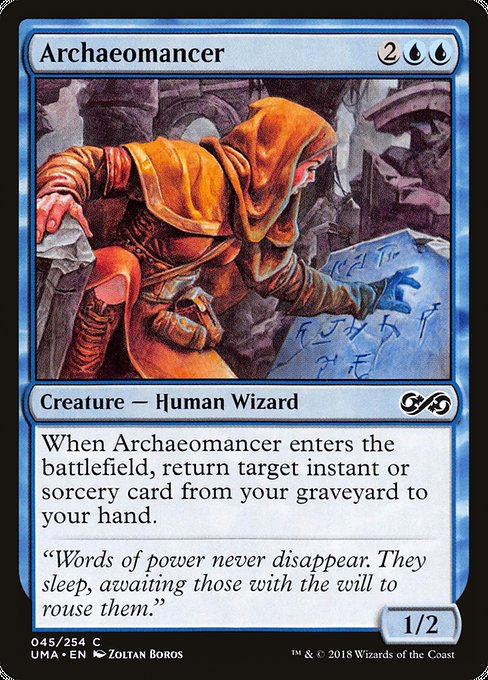
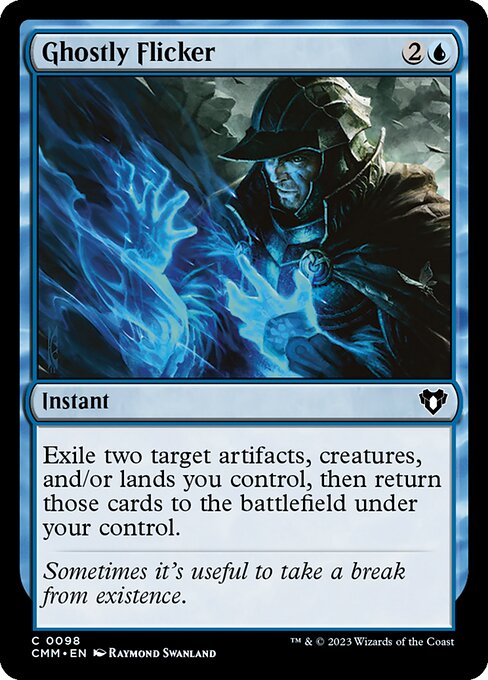
If you include Peregrine Drake, any or all of Archaeomancer, Mnemonic Wall/Salvager of Secrets/Scrivener, and either or both of Ghostly Flicker and Displace, you have infinite mana when you assemble one card from each of those groups with lands that tap for at least four mana in play. You can also play Cloud of Faeries, and then you have infinite mana if you have two lands that tap for four total mana, or two lands that tap for three mana and something that makes blue spells cheaper to cast. In addition to infinite mana, you have the ability to use the mana to infinitely flicker your Mnemonic Wall or equivalent and another creature after you’ve made that mana. So if you have any creature that does something productive, you get to do that thing infinitely.
This is a pretty small package of cards that are all reasonable to actively good when drawn without the rest of the combo in most blue pEDH decks. Such that I suspect that roughly any deck that includes blue is stronger if it includes all of the pieces for this combo than if it doesn’t.
Once your deck has all the pieces, it’s hard to find something stronger to do that focus on assembling the combo. Roughly all blue decks should converge into doing this thing.
Incidentally, it was only now that I actually bothered looking at some public decks on Moxfield to see how often blue decks were actually doing this. I think I’m most surprised by seeing multiple decks playing all the cards that support Peregrine Drake without actually playing Peregrine Drake. I don’t know if these players simply don’t know about it, or if this is an intentional choice to avoid playing the infinite combo. (Personally, I’d say that if they’re intentionally avoiding it, I’d take that as a sign that those people would probably support a ban. I’d infer that they’ve independently decided it makes their games worse.)
So, with the, “please remove this from the format” out of the way, let’s take a look at the process one should go through when building a blue pEDH deck at the moment, if one’s trying to win.
First, play all the cards I’ve mentioned. They’re all blue, so you can play them in whatever blue deck you want to play.
Next, play some creatures that do things when they enter the battlefield, especially those that draw cards. You’re playing flicker effects anyway, so you might as well make them good, and they’ll help you find your combo. You have a couple dozen options in blue alone, I’m not going to list them all. Some are better than others. Season to taste.
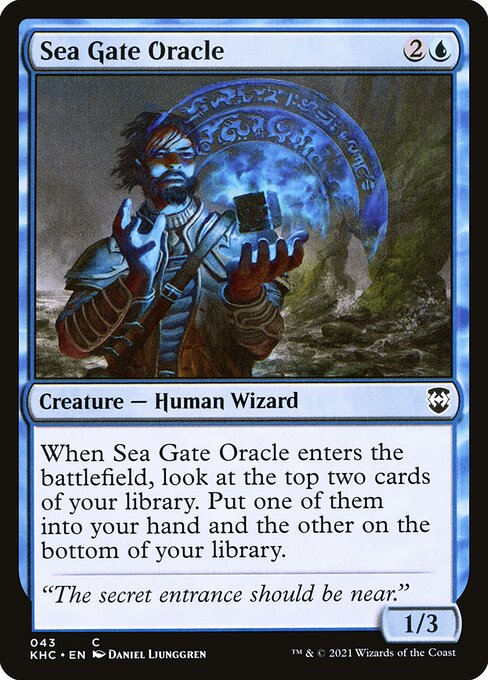
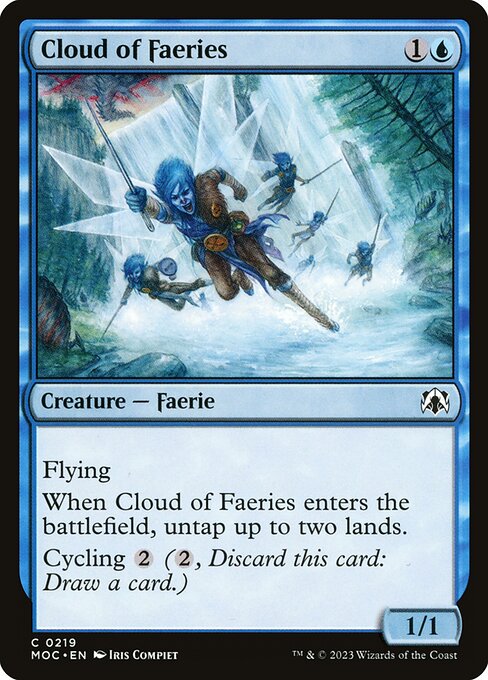
You should decide whether you’re trying to use Cloud of Faeries as an alternate Peregrine Drake. I recommend doing so. You can use High Tide so that you can go off with two Islands, but you don’t necessarily want to, since it’ll likely be bad in your deck otherwise. You should play any of the Ravnica Bounce Lands your colors allow, as well as Sunscape Familiar or Nightscape Familiar if those are in your colors. If you’re playing green you can also use land-based auras like Wild Growth and Utopia Sprawl to make it easier to go off with Cloud of Faeries.

You likely want to play some tutors to find your pieces. In blue, you can play Dizzy Spell and Merchant Scroll to find High Tide if you want to try to go off with Cloud of Faeries. You can use Muddle the Mixture to find Cloud of Faeries. You can use Drift of Phantasms or Merchant Scroll to find Ghostly Flicker or Displace, and you can use Step Through and Vedalken Aethermage to find Salvager of Secrets, Scrivener, or Archaeomancer.
If you’re playing Black, Brainspoil can find Peregrine Drake or one of the Salvager of Secrets type cards, Dimir Infiltrator and Shred Memory can find Cloud of Faeries, and Dimir House Guard can find Archaeomancer. Mystical Teachings can also find High Tide or Ghostly Flicker/Displace and Perplex can find Ghostly Flicker/Displace.
I don’t necessarily recommend playing all the tutors. I personally prefer playing more of a value/control game and finding the combo eventually, since I think spending a lot of mana building your hand leaves you pretty vulnerable to removal, which can disrupt the combo. Speaking of, I also recommend having ways to get your creatures back from your graveyard. There are a lot of black cards that do this, of course, but green also has some good options, like Evolution Charm, Grapple with the Past, Druidic Ritual, Pulse of Murasa, Season of Renewal, Survivor’s Bond, and Wildwood Rebirth. The more ways you have of getting your combo pieces out of the graveyard, the more you should consider playing cards that mill you to help find your combo.
I’m also a huge fan of Stream of Thought as a way to put cards back into your deck if you don’t think you can get them back from your graveyard directly. It doubles as a way to kill all of your opponents once you have infinite mana.
If you’re really dedicated to the combo, you’ll definitely want all the cheap cantrips like Brainstorm, Opt, Consider, Ponder, etc to find your pieces, and you’ll want Dispel and probably some other counterspells to protect yourself when you try to go off. Perhaps even Duress if you’re playing black to target the player you think is most likely to be able to stop you on your combo turn.
These packages can be pretty seamlessly integrated into decks with a variety of commanders, since “value” as a subtheme is so generically strong in pauper. Let’s take a look at some examples from my own decks.
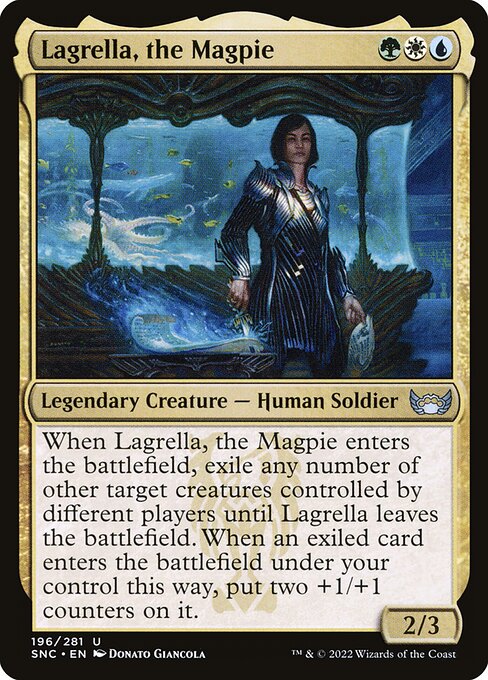
First, my Lagrella, the Magpie deck.
This deck makes excellent use of Lagrella, which is a very strong commander for keeping opposing commanders in check. When you play Lagrella and attempt to exile your opponent’s commanders, they have to decide if they want to let them stay under Lagrella for as long as Lagrella stays on the battlefield, or put them in the command zone and increase the tax. If they put them in the command zone, you can flicker Lagrella. Additionally, Lagrella is great at cleaning up tokens, which are fairly popular in the format. This also makes Resculpt an excellent removal spell for you.
Lagrella naturally wants to play with value creatures, meaning the whole deck revolves around a blink package. The Peregrine Drake combo package is a seamless fit, as I’d be playing all the supporting cards even if Peregrine Drake weren’t legal.
I’m playing a few land auras I wouldn’t otherwise play to support Cloud of Faeries as a combo piece, but there’s basically no cost to playing them, since they’re reasonable ramp spells on their own.
I’m playing a small fog package–aside from generally helping against aggressive decks, if I get multiple Archaeomancer-type cards with Displace/Ghostly Flicker but I don’t have Drake/Cloud I can flicker both Archaeomancer types to get back flicker and Tangle/Respite/Moment’s Peace to lock out combat damage.
This deck is definitely board control/card advantage first, combo as an afterthought, which I do think is stronger, since the combo’s pretty fragile (disrupted by any instant speed removal spell).

Next, there’s me Vohar, Vodalian Desecrator deck.
This deck plays very differently. I have less ramp and less board presence. Vohar plays as a more traditional control deck, but Vohar digs through cards quite a bit faster, meaning it should find the pieces to threaten the combo much faster on average.
Stinkweed Imp with Vohar lets me tear through my library to get all the necessary pieces in my graveyard. Any of my Raise Dead-type spells can get back an Archaeomancer-type card or vice versa to reassemble all the pieces.
This deck includes a madness theme to get the most out of Vohar along with some minor self mill and graveyard themes. Gurmag Angler, Tolarian Terror and Writhing Necromass theoretically represent a backup plan of sorts. Realistically, this deck is generally trying to win by comboing, but the card selection offered by Vohar spares me the trouble of needing to play transmute cards to find the combo.
I haven’t played the format enough to know that these decks are appreciably more likely to win than whatever the strongest non-blue decks are. I do think the format supports decks that are sufficiently linear, to the point where they don’t want to play these cards. But, my first impression is that the combo seems stronger than most other options. As a deck builder, it’s hard for me to see how the combo doesn’t collapse most blue decks into the same play pattern, as I hope these decks have demonstrated, as I think they’re very different kinds of decks. I suspect the feeling of playing against them would tend to get a little too familiar.
Sam Black (any) is a former professional Magic player, longtime Magic writer, host of the Drafting Archetypes podcast, and Twitch streamer. Sam is also a Commander Cube enthusiast, and you can find Sam’s cube list here. For anything else, find Sam on Twitter: @SamuelHBlack.

